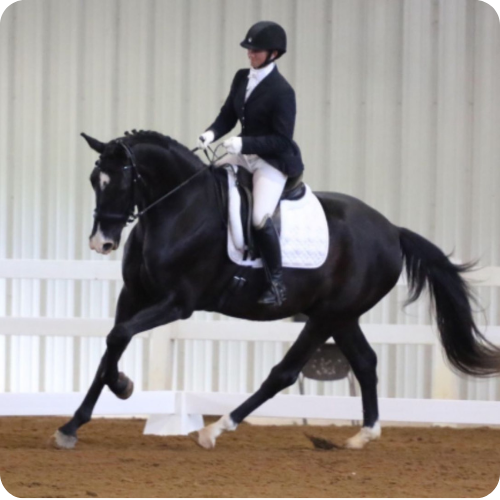
Ristocrat’s Return: Making The Most Of Time Off
Call us today at 📞 434-973-7947
Ristocrat’s Return: Making the Most of Time Off
There it was, the news that horse owners dread to hear: the young, beautiful, talented warmblood that she bred had a suspensory tear. All the momentum of his promising career in dressage seemed to have ground to a halt, and now a new goal loomed. Roberta Falk was determined to pursue the best course of treatment for Ristocrat to put him back on the road to success.
The diagnosis was made by performing regional anesthesia (selectively blocking nerves in the lower leg to determine where the pain is) and ultrasound. The ultrasound examination also gave the information that Ristocrat’s injury was likely to benefit from regenerative treatment. It was decided to treat the tear with stem cells. Appointments were made, stem cells were harvested and processed and then injected into the injured areas using ultrasound to guide the needles.
Regardless of other interventions, time, rest, and controlled exercise (emphasis on controlled) is the basis of healing any soft tissue injury. Most horses spend 8-9 months, sometimes more, in a program of slowly increasing exercise before they are back to full work and allowed unrestricted turnout. Each animal is an individual, and every injury heals at its own speed, making the timing of changes to the program difficult. This timing is also key to keeping the progress going as efficiently as possible while avoiding further injury. The use of ultrasound to monitor the healing of these structures has vastly improved our ability to successfully guide rehabilitation in these injuries, improving outcomes from up to 50% success to up to 80% success.
Ristocrat had some challenges up his sleeve, though. Shortly after he returned home after his regenerative medicine therapy, his leg swelled up and was hot. Ultrasound of the leg confirmed that his body was having an exaggerated response to the biological therapies. Cold hosing, wrapping, and a few days of bute got things quieted down again. Fortunately, he was happy in his stall and enjoyed his hand walking, and when he was checked again the next time, significant healing was seen on ultrasound, and he graduated to the next level of exercise.
As he was asked incrementally to do more work, his muscles and joints were kept loose and limber with chiropractic adjustments. Little by little, more work was added at a pace dictated by the pace of his healing. He returned to full work and was working well. He started showing, and he was doing well. After a short vacation, however, it was noted that he would skip off of that front leg at the trot in tight turns. After cantering, his gait was normal. Ultrasound examination of the suspensory showed some scar tissue at the old injury site. Shock wave was used along with exercise to break down the dense scar so that the ligament could stretch freely. The skipping has not returned.
Without ultrasound, determining the pacing of rehabilitation is difficult at best. Horses that heal more slowly need to progress through their rehabilitation program at a slower pace, and this cannot be determined by the horse’s soundness alone. Not all horses can be on the same schedule. Also, knowing the cause of a gait problem (injury vs. scar tissue) allows the correct course of action (rest vs exercise) to be determined. Ultrasound has helped Ristocrat get back to work efficiently and safely. Once again, the future is bright for this lovely sales prospect and his team.
Get Care
© Blue Ridge Equine Clinic | Privacy Policy


